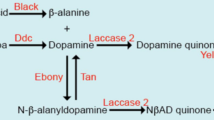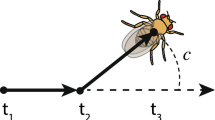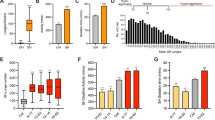Abstract
IN Drosophila, phototactic behaviour can be quantitatively described using Hirsch–Hadler classification mazes1. Flies entering the maze make a series of 15 consecutive light–dark choices and receive phototactic scores ranging from 1.0 (highly photonegative) to 16.0 (highly photopositive). A photoneutral population has an expected mean photoscore of 8.5. The phototaxis maze has provided a useful tool for the characterisation of phototactic behaviour in natural populations of Drosophila and for the creation of photopositive and photonegative strains of flies by artificial selection. Natural populations of D. melanogaster and D. pseudoobscura are photoneutral in general, but respond rapidly to selection for positive or negative phototactic behaviour2,4,7,8. Genetic analysis of phototaxis in Drosophila suggests that this behaviour is a polygenic trait with low heritability3,4,6. Suspension of artificial selection results in rapid reversion to photoneutrality which illustrates the principle of genetic homeostasis and suggests that changes in fitness accompany selection for photopositive and photonegative behaviour8.
This is a preview of subscription content, access via your institution
Access options
Subscribe to this journal
Receive 51 print issues and online access
$199.00 per year
only $3.90 per issue
Buy this article
- Purchase on Springer Link
- Instant access to full article PDF
Prices may be subject to local taxes which are calculated during checkout
Similar content being viewed by others
References
Hadler, N., Biol. Bull., 126, 264–273 (1964).
Hadler, N., Genetics, 50, 1269–1277 (1964).
Woolf, C. M., Behav. Genet., 2, 93–106 (1972).
Markow, T. A., Genetics, 79, 527–534 (1975).
Markow, T. A., Behav. Genet. (in the press).
Richmond, R. C., Am. Nat., 103, 315–316 (1969).
Spassky, B., and Dobzhansky, Th., Am. Nat., 101, 59–63 (1967).
Dobzhansky, Th., and Spassky, B., Proc. natn. Acad. Sci. U.S.A., 62, 75–80 (1969).
Grossfield, J., Behav. Genet., 2, 311–319 (1972).
Marinkovic, D., Behav. Genet., 4, 301–303 (1974).
Mayr, E., Animal Species and Evolution (Harvard University Press, Cambridge, Massachusetts, 1963).
Author information
Authors and Affiliations
Rights and permissions
About this article
Cite this article
MARKOW, T. Effect of light on egg-laying rate and mating speed in phototactic strains of Drosophila. Nature 258, 712–714 (1975). https://doi.org/10.1038/258712a0
Received:
Accepted:
Issue Date:
DOI: https://doi.org/10.1038/258712a0
This article is cited by
-
Starvation-Induced Dietary Behaviour in Drosophila melanogaster Larvae and Adults
Scientific Reports (2015)
-
Relationships between light dependent fitness of Drosophila melanogaster and D. simulans and their genotypes for pupation site photopreference
Genetica (1986)
-
Genetic analysis of sex appeal inDrosophila
Behavior Genetics (1984)
-
The role of female movement in the sexual behavior ofDrosophila melanogaster
Behavior Genetics (1982)
Comments
By submitting a comment you agree to abide by our Terms and Community Guidelines. If you find something abusive or that does not comply with our terms or guidelines please flag it as inappropriate.



